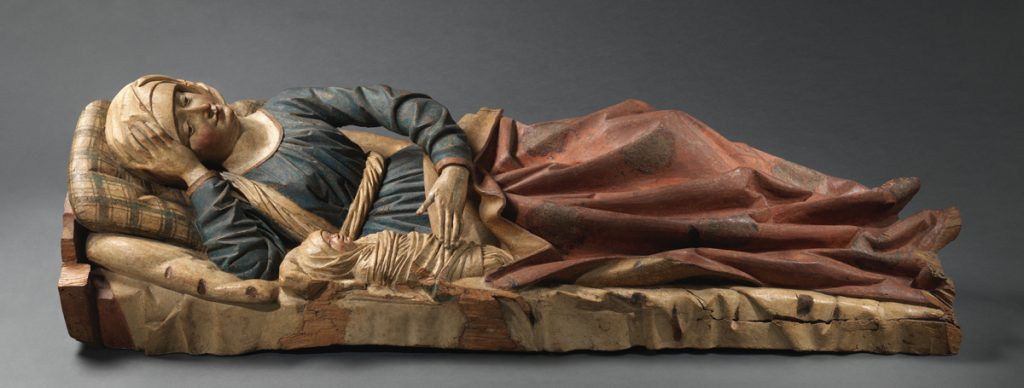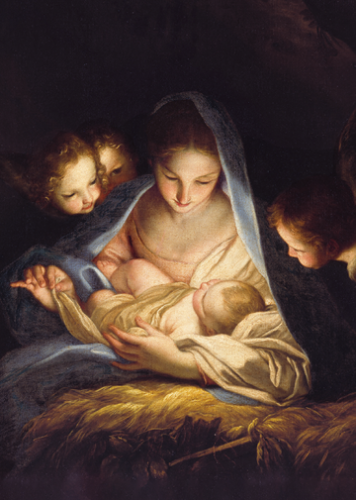Nativity of the Virgin (c. 1480),
anonymous.
Shipwrecked in time
In 1703, a stylish Baroque reredos (the decorated “backdrop” commonly seen behind the high altar) was installed in the Saint Anne chapel of Saint Lawrence Church in Ebern (Bavaria). The previous reredos, which dated from the late 15th century, was dismantled, and some elements of it were certainly reused elsewhere. Studies of the sculpture depicting Saint Anne and Mary, her newborn child, which is presently on display at the Cloisters in New York, reveal that the bed on which the new mother rests, which was originally complete, was cut up, and that two angels stood in front of Saint Anne, on either side of the child, probably holding a crown over her head. What did the whole set of figures look like? It is very difficult to say, because of the great originality of this work. Indeed, this Nativity of the Virgin was probably the praedella, the lowest part of the reredos: now this is an unusual choice, since as a general rule the praedella of a sculpted and painted reredos (which was very common during the early Renaissance in northern Europe) was made up of little juxtaposed scenes. At some point in its history, perhaps after being taken down from the altar of Saint Anne, this Nativity was an object of pious devotion: marks left by the flames of candles are visible down the length of the bed. Very few clues remain, then, to the past of this very delicate work of art, in which everything was carefully designed, as the gilding (now deteriorated) on the red mantle of Saint Anne testifies: the gold leaf decorations, which were applied to a support made of gesso (a plaster-based coating), gave this garment the appearance of a rich brocade.
Contemplative motherhood
The late Gothic era was a period of sometimes excessive, almost mannered refinement: in its simplicity, this Nativity of the Virgin retains only the graceful poses and the play of curves, which is present at all levels, both in the movements of Saint Anne’s fingers and in the gesture of her arm, which is slightly disproportionate in length; both in the tilt of the head and in the billowing of the cloak, which suggests that the knees are raised. The anonymous artist played with the very numerous folds in the fabrics; he multiplied the guidelines: horizontal, of course, but also vertical with the waistband, the pillow, and the edge of the cloak, and even circular if you consider the way in which the two arms of the mother form a harmonious oval with her face and the newborn. These elements, together with the pensive gaze of Saint Anne, who strangely enough is not looking at the swaddled infant, with her peaceful, almost spiritual smile, and with the realism of the gesture of the right arm holding up her head, enable this reclining body to give an impression of great serenity without the slightest hint of the immobility of death. It scarcely gives an impression of fatigue; this birth is above all contemplation. The baby, too, with her eyes half-closed, is smiling. And we marvel all the more at the sight of this endearing face, because it is the Mother of God herself and our Mother whose birth is presented in this way, through the eyes of Saint Anne, for our own contemplation.
The feast of the Nativity of the Blessed Virgin Mary falls on September 8 (which explains why we celebrate the Immaculate Conception nine months earlier, on December 8); it is remarkable for being one of the most ancient. Officially instituted in the 7thcentury, it was celebrated from the 5th century on, in Jerusalem itself, where tradition situated a “house of Anne.” Moreover it brings the West and East together in one and the same gladness. However it is not rooted in the New Testament, but rather in the apocryphal Gospel of James, called the Protoevangelium because it relates events before the birth of Christ. In particular it tells about the miraculous birth of Mary, as a result of the prayers of a sterile couple: Anne and Joachim.
The all-pure dawn of salvation
Even though her fiat is what really opens for us the way of salvation, by making the Incarnation of Jesus possible, Mary’s own birth contains in miniature the coming of the Savior, his Death and Resurrection. “And so, from the first moment of her conception, that is, of her existence,” John Paul II writes, “she belongs to Christ, she shares in the saving and sanctifying grace and the love which has its source in the ‘Beloved,’ in the Son of the Eternal Father who, through the Incarnation, became her own Son.” The swaddled infant here prefigures another infant, whose wrappings would already proclaim the linens of the empty tomb. The poet Charles Péguy could have had before his eyes the Nativity of Mary from Ebern when he meditated on the purity of Christ’s Mother, which was unique in a creature of flesh: “So that nothing pure remained except half of the angels./ And none of the men,/ Not one human person/ In all creation./ [Nothing remained] of the native purity, the young purity, the first purity, the created purity, the infant purity, the purity of creation itself./ When this unique creature was created,/ Blessed among all women,/ Infinitely unique, infinitely rare, Now./ Infinitely pleasing to God./ And at the hour of our death, Amen,/ Surpassing all women./ When finally, when one day of the ages this unique creature/ Was created for eternity, for the salvation of the world./ In order to be the Mother of God.”
Delphine Mouquin
Delphine Mouquin holds a PhD in literature.
She is a frequent contributor to the French edition of Magnificat.
Nativity of the Virgin (c. 1480), anonymous, Metropolitan Museum of Art, New York. Public domain.













Additional art commentaries